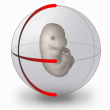

Methodology of spatial pattern comparisons and subsequent
heirarchical clustering
|
Raw data images |
Corresponding spatial annotations |
||||||||||
|
|
||||||||||
|
|

For example, Jaccard Index
similarity values of the patterns denoting combined strongest,
moderate and weakest signal intensities for the Pax6,
Sox10 and Dlx5 examples above would be: |
||
 |

Viewing Option 1 A java applet can be started straight from the web browser. The applet is based on Java TreeView (see below) and has been enhanced to allow viewing of image data on the cluster tree. You can click on the tree and view heat map representations of sites in the embryo that express the genes on each branch. The contributing raw data images for the selected branch may also be viewed. A slider tool is available to select multiple branches from the tree, and the tree can also be searched for examples of a gene of interest or EMAGE:IDs. You may have to increase your system's Java Memory to load large trees in this viewer. |
 |
Viewing Option 2 The images are arranged (left to right) in rows according to the order (top to bottom) that they appear in the tree described above. This places the images into blocks that display similarities of expression pattern (but provides no information as to the tree structure). |
 |
|
Viewing Option 3 You can load the approriate .cdt, .gtr and.atr files (these can be downloaded from the relevant emage cluster analysis page) into the original version of Java TreeView, This was developed by Michael Eisen for viewing the output of clustered microarray data and can be downloaded here. |
|
This image shows the dendrogram and the identities of the corresponding branches in JavaTreeView. The left panel display the dendrogram and corresponding colour matrix which relates to the output values from the Jaccard Index values (ranging between intense red for a value of 1, to black for a value of 0). A branch has been selected and is shown in red.The middle panel displays a close-up of the matrix for the selected branch of the dendrogram. The right panel lists the genes which correspond to each branch. TreeView can be formatted such that the gene names link to the EMAGE database to show data images. |
 |